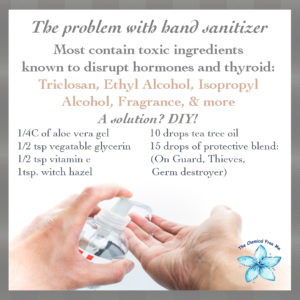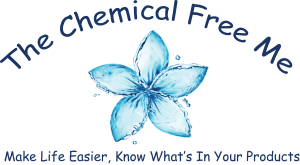Toxins in Hand Sanitizers Create a Bigger Problem
The crisp fall weather means those first colds and the paranoia of germs. Hand sanitizer is everywhere! We want to stay healthy and prevent the spreading of germs but is coating our hands in hand sanitizer actually  the answer? Personally I stay away from them. I am blessed with a decent immune system, built on four kids worth of germs and having taught preschool for 19 years.
the answer? Personally I stay away from them. I am blessed with a decent immune system, built on four kids worth of germs and having taught preschool for 19 years.
Having searched high and low, I can’t find a single one that contains NO sketchy ingredients. Even those on the safer end of the EWG rating scale, all include some less than perfect ingredients. I find very few situations where there is no place to wash my hands or a nice scrub with the kids wet wipes won’t accomplish enough for me to get by. Since that is not the case for everyone, let’s look at the best possible scenarios.
What to avoid
First and foremost avoid Triclosan. The FDA has recently banned 19 ingredients, including Tricolsan however the new regulations do not include hand sanitizers or wipes. Starting January 2017 it is banned in Minnesota products. It HAS been proven to cause thyroid and hormone disruption in animals. A major pitfall is that it takes 1 minute for Triclosan to kill germs. Most people do not wash their hands or use hand sanitizer for an entire minute so the effectiveness has not quite weighed in.
Ethyl Alcohol: This is what kills the germs. It also enhances the absorption into the skin of other chemicals. (So take note if you are using one that contains Triclosan). Unfortunately for your skin it also dries out the natural oils. Making your skin dry enough to have cracks would increase the ability of germs to get in. An alarming observation? Adults have shown to have alcohol in their blood stream after using large amounts of hand sanitizer. Children have never been tested.
Isopropyl alcohol: This is a known neurotoxin with a 4 rating on the EWG site.
Fragrance: Fragrance is that one tiny word that may contain any of up to over 3,000 ingredients including phthalates. Many are toxic and have never been tested for safety. (Essential oils will be listed as essential oils, not as fragrance) Fragrances rate an 8 out of 10 on the toxic scale!
Amino methyl propanol: Shown to be an endocrine disruptor and having respiratory effects.
Tocopheryl acetate. This is a tricky one for consumers. Tocopheryl is Vitamin E. However-this ingredient is vitamin E with an added acetate group now making it a 4 on the toxicity scale and certainly not as natural as vitamin E.
Propylene glycol: An ingredient found in antifreeze, processed foods, and cosmetics. It can be irritating to the lungs, skin and eyes.
Solutions
For my family, I opt for washing hands when possible as a first choice. A second choice is pulling out the water wipes (at least we are getting the dirt off right?) Last choice when needed is my DIY hand sanitizer.
Disclaimers: Judgment call: If we are at the local farm and there is no running water I will opt for my hand sanitizer over theirs before we eat. If my child were sick in the hospital I would likely take my chances with the toxins and use theirs. Obviously my DIY hand sanitizer has not been tested for how much bacteria it can kill, nor have any others from what I can find. Essential oils have shown to have natural antibacterial, antiviral and anti fungal properties. Tea Tree has been tested in clinical studies (link to study https://nccih.nih.gov/health/tea/treeoil.htm).
There are MANY variations to this recipe and you can add and tweak as you like.
1/4C of Aloe Vera Gel
1 tsp of Witch Hazel (omit if you wish to keep it alcohol free or if using on children under 2)
15 drops of Germ Destroyer
10 drops of Tea Tree Oil
½ tsp Vegetable Glycerin
½ tsp of Vitamin E.
Want us to make it for you?
